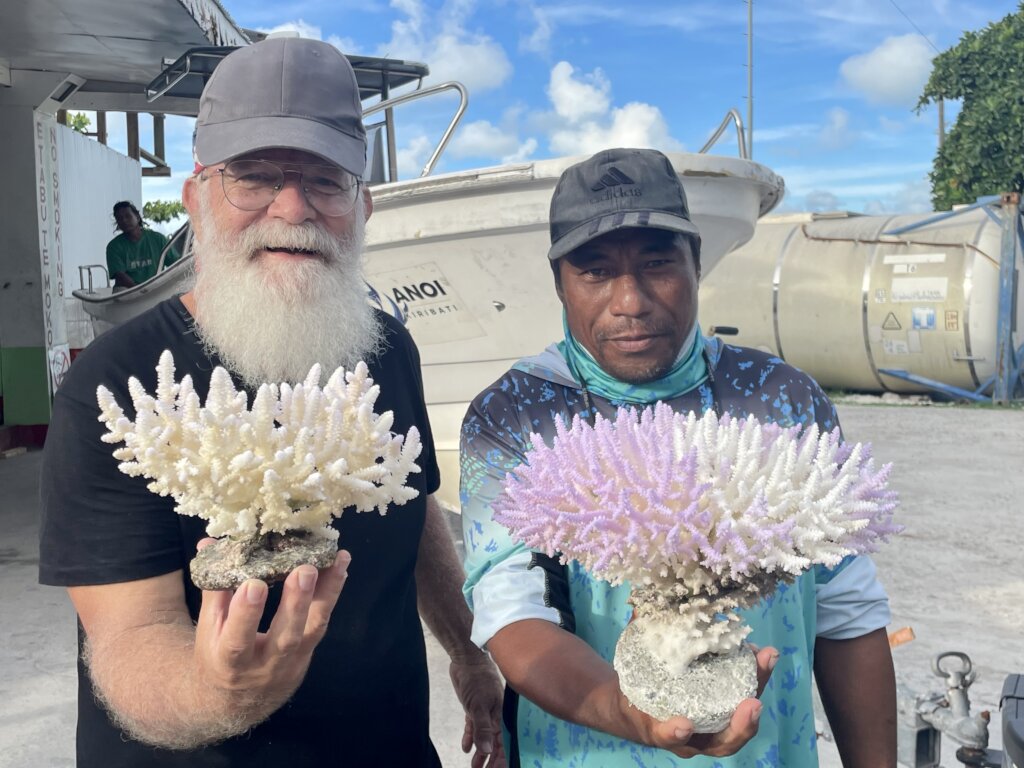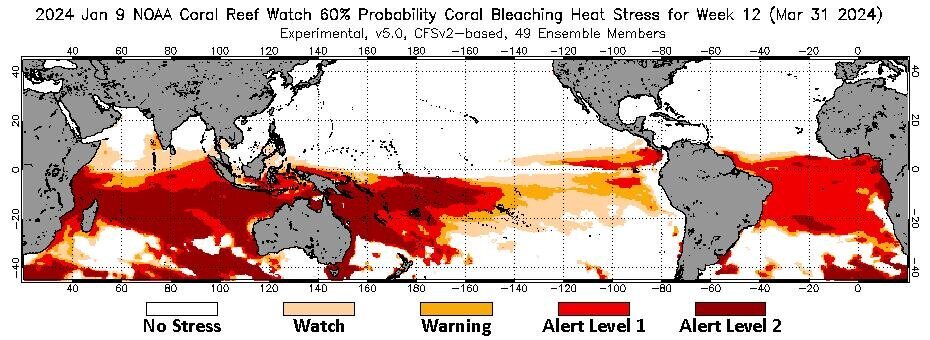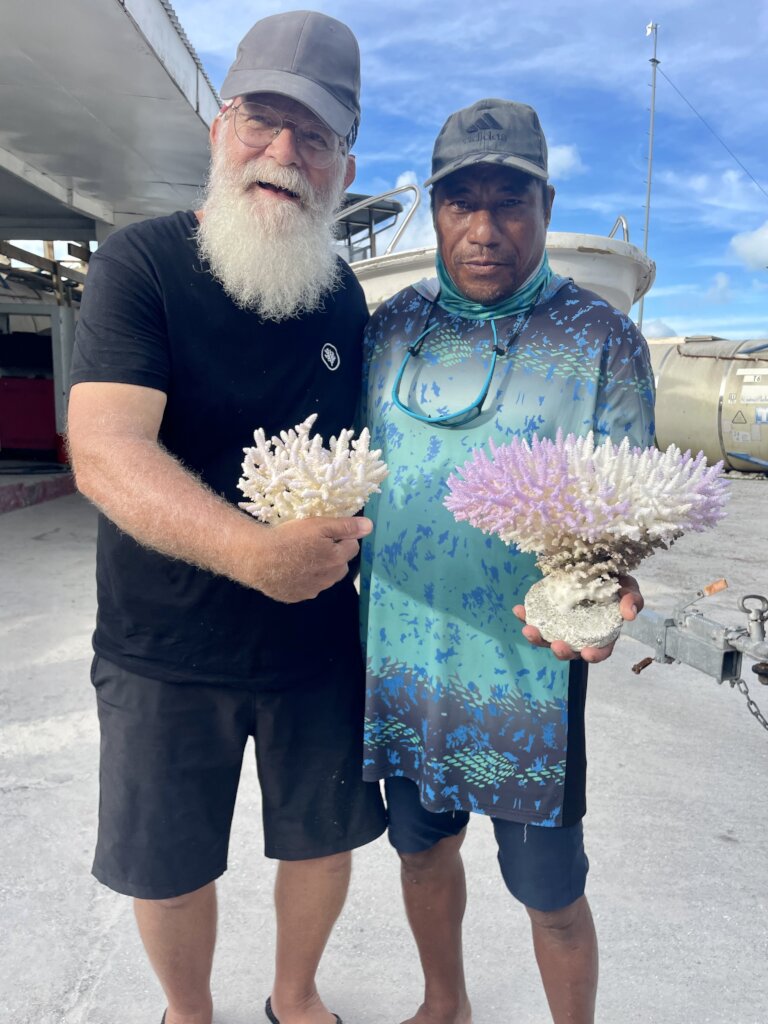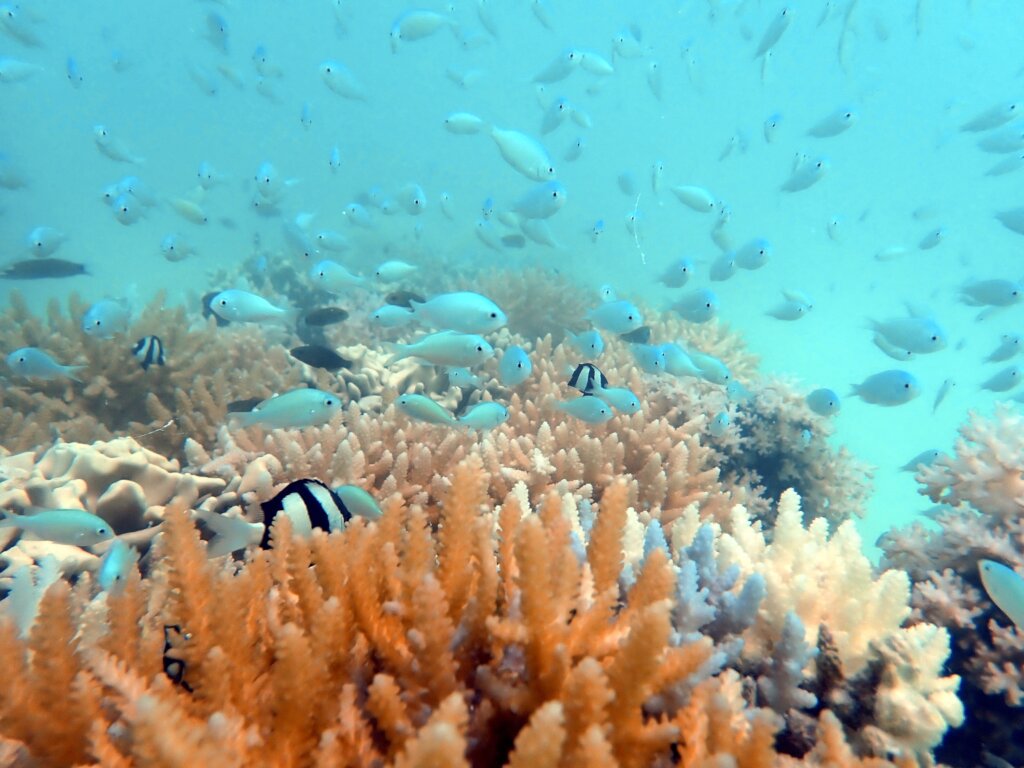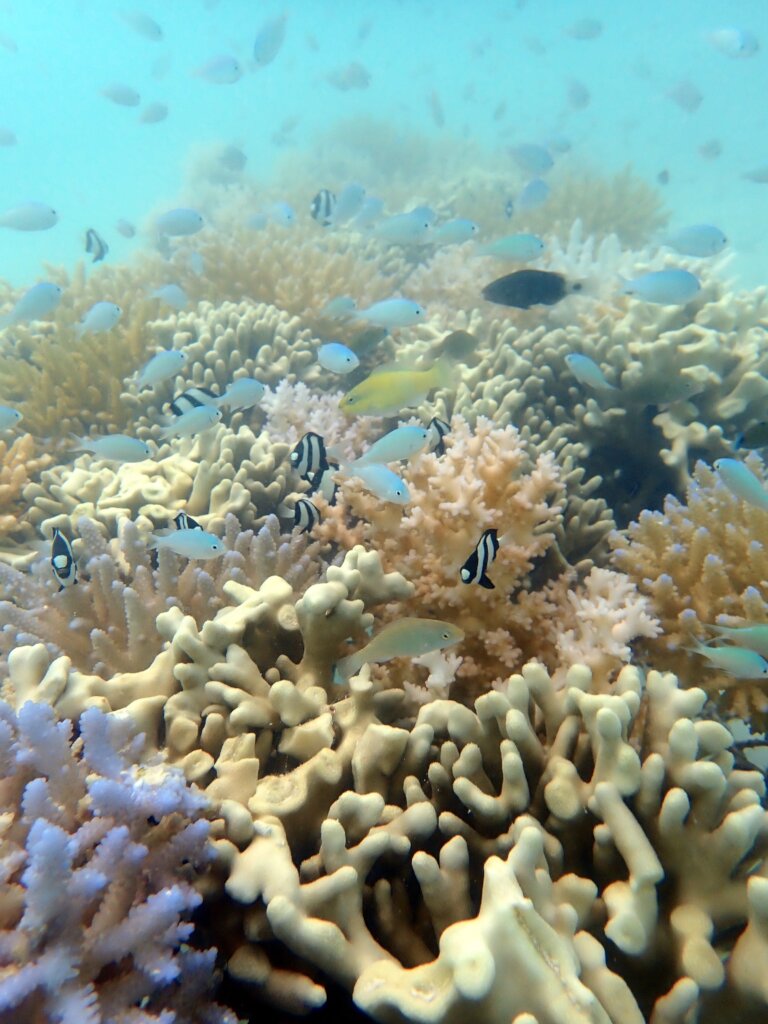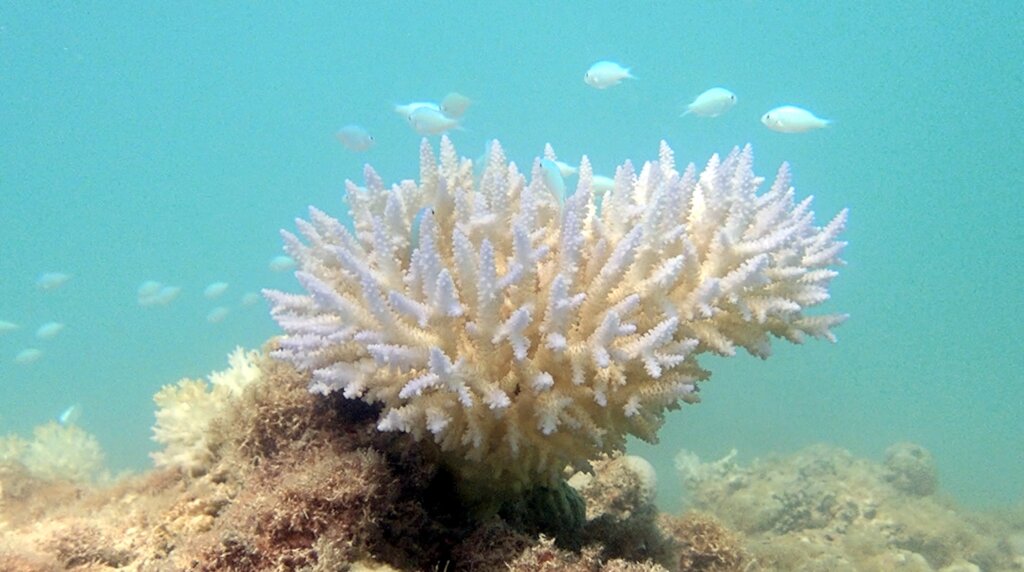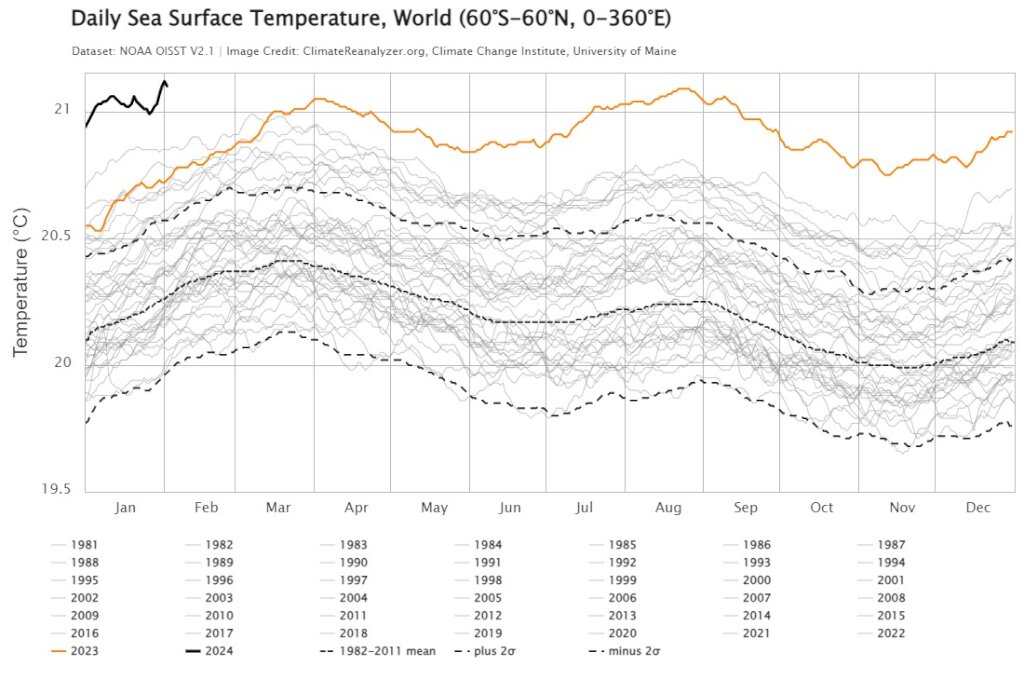The much-touted heat wave for Pacific Ocean waters was arriving as we begin 2024. The leading edge had already borne down upon equatorial Kiribati, the island chain adorning earth's belt. Hence, Kiribati sits in the doldrums -- without the benefit of additional wind and current action. We're witnessing the corals, which were making a significant comeback after a horrific die-back, bleach once again. Most will likely perish -- though the jury is still out if the damage will be at 98% as it was in 2015/2016.
The marine heat wave is now heading our way:
Unfortunately, the hot waters which killed many of Kiribati's corals are now centered over Tuvalu, where the deep ocean channel is already 31C (88F), and the shallow coral reefs are upwards of 33-35C (91-95F). A mass coral die-off can be expected on many reefs here. The marine heat wave which was predicted not to reach as far south as Samoa or Fiji has been updated. The most recent data shows severe heat moving toward Samoa, and with each updated prediction the prognosis worsens. Right now, moderate marine heat stress conditions are already here and they can be expected to worsen on Fiji's reefs, and to hold until April. Malolo and leeward Vanua Levu waters are already at 30C (86F), while the rest of Fiji is 29C (84F). Sadly, the moderate bleaching is predicted to impact much of the region.
The biggest wild card in what develops are near-miss and even far-miss cyclones, which cool off the ocean and vastly change the outcome. This is based on numerous reports and years of experience. Just last summer, the cooling impact of four Vanuatu/ New Caledonia cyclones saved the Western Division of Fiji from a mass bleaching that impacted the Eastern and Northern Divisions. Last year parts of the Caribbean like Belize, Nicaragua, and Panama saw storm-related cooling in their very stressful summer, but the heat returned.
On a more positive note, Fiji's reefs have shown some amazing resilience to hot waters, indicating that heat resistance can evolve over time:
There is evidence from the three most severe bleaching events which have hit Fiji in 2000, 2014, and 2023 -- each of relatively equal intensity -- that marine heat waves are having less impact with each subsequent stress event. Coral mortality was roughly 80% in 2000, 60% in 2014, and perhaps 30% in 2023.) However, some coral genera experience considerably more mortality than others, so species phase shifts can occur over time. Hopefully, a proper scientific report on this phenomenon will soon exist.
While the impacts of what is developing to Fiji's reefs are yet to be seen, it is necessary to discontinue carrying out routine coral gardening and transplanting work during these hot and high UV summer conditions.
This is the time to pause until the waters cool off and UV levels drop. Kiribati is an exception, as it straddles the equator, but even there, we suspend coral work during more stressful times. For Fiji, this is the time to closely monitor coral work done over the past year, especially any work done since the end of our cool season in September/October, to try to determine the best cutoff month for coral planting.
The NOAA models were unable to predict the severe and unprecedented Caribbean bleaching. It is now clear that these models are consistently underpredicting 2-3 months out, apparently relying on the old temperature baseline. (I think the 60% bleaching probability may actually be closer to 100%.)
If it were not for the poor NOAA track record of 2023, there would be no reason to believe that the present bleaching threat has the potential of reaching at extreme level, because all three of the worst bleaching events in Fiji have occurred during La Nina years, and this is an El Nino year -- so why worry?
However, we should still be prepared, as Kiribati just experienced the most stressful event in their history, and Tuvalu is now also suffering the same record-breaking mass bleaching, following on from the extreme off-scale bleaching that Florida and the Caribbean just experienced. We need to remain vigilant. Recent history tells us that the 2024 event has the potential to far exceed NOAA predictions. Therefore, as we do with cyclone preparations, it is better to overprepare than to underprepare.
I have attached today's update on mean ocean temperatures below, showing the off-scale marine heat resulting from a tipping-point level change in the planetary heat budget.
This is what is behind the under-predicting NOAA models. The earth's thermostat broke last March! We are approaching 6 standard deviations above the mean now as it slowly creeps upward. Earlier suggestions that the anomaly was caused by the Tonga volcanic eruption or changes to global sulfur emissions from reductions in shipping, or to El Nino conditions, have now all been proven inadequate to explain what we are experiencing. A possible cause is that Ocean Overturning Circulation has slowed, and that this sudden warming may indicate that the decade-long process of AMOC collapse has already begun, with severe planetary consequences. https://www.youtube.com/watch?v=j2ETr6X1lOk
Our 1.54C over baseline 2023 was not expected for decades. Now temperature readings are consistently running above the 1.5C threshold that the UN Paris Accord set. 2023 was the hottest year on record, and 2024 is so far even hotter. If the new thermal baseline becomes permanent, with the graph below becoming the norm, then mass bleaching conditions can be expected just about every year during the summer months. I am very concerned for what that means for Fiji during our next La Nina phase!
Lastly, those with good background and experience may wish to continue with coral selection for bleaching resistance on a smaller scale to avoid stressing precious corals. Cautiously and carefully, we can proceed to develop emergency measures to save corals from death due to mass coral bleaching. Potentially, this crisis can be used to establish best practice methods.
Hopefully, this scary event will be more of a learning event than a coral die off event. Sooner or later, the coral die offs are coming, and we have much to learn.
You have been steady supporters and have made possible many advancements, not only in diagnosing the problems, but also in finding strategies to cope with what lies ahead.
With heartfelt gratitude,
Austin
